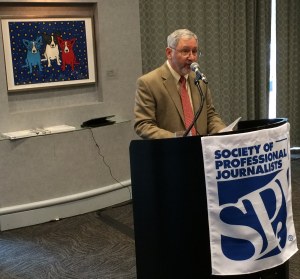SPJ Louisiana is publishing articles written by University of Louisiana at Lafayette chapter members who attended the SPJ Region 12 conference in New Orleans.
by DANIEL BOUDREAUX
Pulitzer Prize-winning environmental reporter Mark Schleifstein of The Times-Picayune, keynote speaker at the Mark of Excellence Awards Luncheon, said environmental journalism in more relevant than ever, especially as breaking news.
Schleifstein lamented that television stations and non-profits like The Lens in New Orleans are now taking the lead in environmental reporting.
“We’ve seen our (print) newsrooms cut to shreds, like my own, with the result being that one or two reporters have to cover what half a dozen or a dozen reporters used to cover,” Schleifstein explained. “On the print side, this has resulted in some of these reporters covering the environment in new venues.”
However, he added, “Never underestimate the effect of breaking news on what remains in newsrooms,” he said. “The next BP or Hurricane Katrina will result in repeats of the all-hands efforts seen in the past, although those newsrooms have much smaller staffs so it’s going to be a much more difficult thing to do than in the past.”

Schleifstein mentioned a study by the Project for Improved Environmental Coverage that found network news has increased its environmental coverage by 13.3 percent, while CNN, USA Today, Fox News and MSNBC saw a drop of only 1 percent in their environmental coverage.
Asked during Q&A how best to deal with climate change skeptics, Schleifstein replied, “I generally try to point people to the numbers and to the actual information that’s being put out. In the United States, that can be anything from NOAA (National Oceanic and Atmospheric Administration). NOAA puts out monthly reports how, yet again, this is the warmest month in the history of watching what’s going with the weather, and they have lots of other data that supports that.”
He also cited the U.S. Supreme Court’s ruling on the Clean Air Act when climate change deniers try to get political.
Finally, Schleifstein also told the audience not to underestimate their readerships.
“Don’t underestimate the knowledge of locals,” he urged. “They’re out there every day and they see what’s going on with the weather. They see at least part of the cause of what’s happening out there. They’re very much aware of what subsidence is doing and that the land is disappearing.
“I learned the don’t-underestimate scenario early on in my career when I was back in Suffolk, Virginia, and my editor said, ‘Well, when you start talking about aquifers you have to say water-bearing rock layer,’ and I said, ‘These guys are farmers. They’re drilling wells in their backyard. They know what an aquifer is.’ That’s the reality.”

Schleifstein disputed the so-called “demise” of The Times-Picayune, which is now one-third the size it was in 2005. He also mentioned the cuts to home delivery down to three days a week that drew heavy protest from the paper’s readership.
Yet, he insisted, “We’re still a significant force in the community, despite what has happened.”
He pointed to its recent story on the murder of former New Orleans Saints player Will Smith, which had more than 1.6 million views on nola.com and was the largest single story The Times-Picayune has ever published there, as evidence to his claim.


Leave a comment